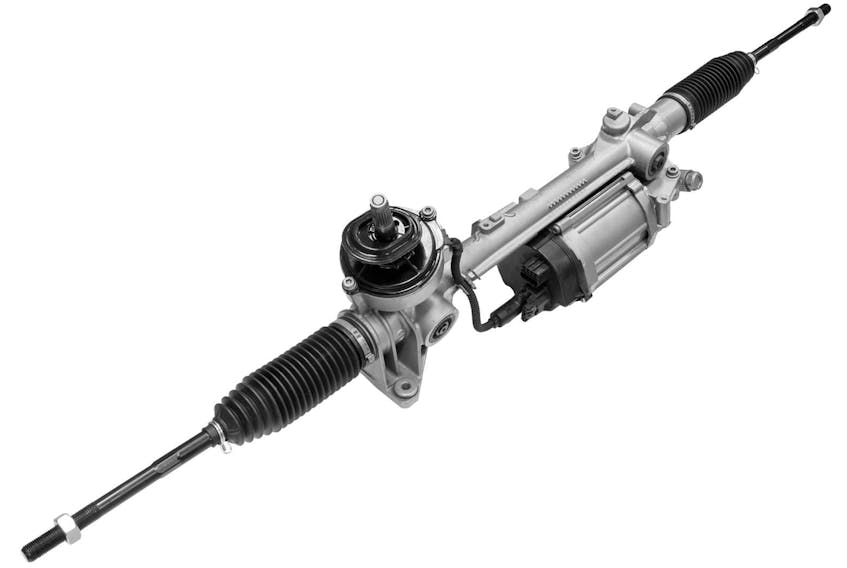Q: What could be causing our steering rack to leak and have to be replaced twice in thirty thousand miles?
We have a 2006 Grand Caravan that was modified new for wheelchair access, by lowering the floor. The modified vehicle is a few hundred pounds heavier than the vehicle before modification. The Chrysler dealer suggests that the steering rack wears out because the van is raised at the rear to improve clearance under the lowered floor.
The van was involved in a minor collision in 2007 that resulted in a cracked front bumper.
Thanks in advance for your consideration.
A: Two problems typically occur with steering racks.
First, there is an internal seal leak on the piston that allows fluid to leak from one side of the piston to the other.
This causes harder steering because the power assist being bypassed.
The second problem is an external seal on the steering rack that falls and allows oil to leak to the outside.
Problems can also occur in the hydraulic control valve area of the steering rack, but these are rare.
Regardless of the problem, the typical repair is to replace the steering rack with a rebuilt or re-manufactured unit. Few shops actually disassemble steering racks for repair.
To help determine why the rack needed replacement a second time, we should look at why it failed the first time. The extra weight of the vehicle may place a slightly higher load on the rack but this would only occur when the wheels are being turned with the vehicle stationary.
Even this should not cause a real problem, as the van was designed for maximum passenger load and I doubt if you operate it this way most of the time.
The raised rear end also should not cause a problem with the rack, although it would change steering angles slightly.
I suspect the first failure may have been just bad luck, but the minor collision may have had something to do with it.
I often see vehicles that have been in collisions that had no obvious damage to the steering but were hit hard enough on a tire or wheel to damage something in the steering or suspension.
Winter accident damage may not show problems until there are smoother roads and better traction in the spring.
The second failure could be related to the first. If the oil in the steering was contaminated with metal particles from the first failure, it should have been flushed before a new rack was installed.
Check the power steering oil and if it appears grey or has small metal flakes in it, then it needs changing.
The second failure could also be caused by a steering rack boot vent tube that was not securely in place, allowing dirt and moisture to get in.
Unfortunately, this would be difficult to determine unless you saw it at the time the rack was replaced. Again, the second failure may have been just a case of bad luck.
Q: I have a 2010 Honda Accord. My air conditioning works but it tends to warm up after 20 minutes of driving.
I have taken it to a few repair shops but have not got feedback that could help me. What should I be doing in my case?
A: There could be a few different problems with your air conditioning, but none are serious. It sounds like the system is “icing up.”
Ice could be forming on the fins of the evaporator so that the air entering the car cannot be cooled, or ice could be forming inside the AC system that restricts refrigerant flow.
Another possible problem is a low refrigerant charge but the repair shops should have been able to diagnose a low charge fairly quickly.
The system needs to have pressure gauges installed on the system (part of normal diagnostics) to determine the problem. If the system pressure is too low in the evaporator, the system is getting too cold causing ice to form.
The thermostatic switch that prevents the system from getting too cold may need changing.
Incorrect pressures inside the system could also indicate a restriction internally.
There will be a temperature change in a hose from one side of the restriction to the other where ever a restriction is located. There may also be frost build up where the restriction is located.
To repair a restriction in a hose, the system will have to be discharged and the hose replaced, but I would bet that your vehicle’s problem is with a faulty thermostatic switch rather than a restriction.
Jim Kerr is a master automobile mechanic and retired teacher of automotive technology. Send your questions for Jim via email or mail them to: Herald Wheels, 2717 Joseph Howe Drive, P.O. Box 610, Halifax, N.S. B3J 2T2 - [email protected]









